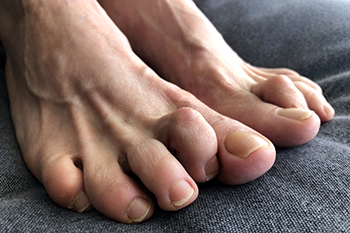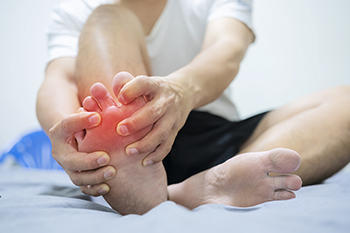Items filtered by date: December 2021
Let the Expert Treat Your Ingrown Toenails
What Do Plantar Warts Look Like?
Plantar warts are non-cancerous, rough growths that appear on pressure points located on the sole of the foot. They are caused by the human papillomavirus (HPV), which is spread through direct contact with a plantar wart or an object where HPV is present. Plantar warts are usually flat, and either brown, gray or flesh-colored. They can sometimes have black dots in the center, which are tiny capillaries that supply the wart with blood. Warts can grow individually or appear in clusters. They may be painful when you apply pressure to the bottom of the foot or walk on them. There are several types of therapies podiatrists can use to remove these warts permanently. If you notice a growth on the bottom of your foot that has the characteristics described here, please contact a podiatrist to confirm that what you see is a plantar wart and to receive proper care.
Plantar warts can be very uncomfortable. If you need your feet checked, contact Cory Brown, DPM from Cory Brown, DPM. Our doctor will assist you with all of your foot and ankle needs.
About Plantar Warts
Plantar warts are the result of HPV, or human papillomavirus, getting into open wounds on the feet. They are mostly found on the heels or balls of the feet.
While plantar warts are generally harmless, those experiencing excessive pain or those suffering from diabetes or a compromised immune system require immediate medical care. Plantar warts are easily diagnosed, usually through scraping off a bit of rough skin or by getting a biopsy.
Symptoms
- Lesions on the bottom of your feet, usually rough and grainy
- Hard or thick callused spots
- Wart seeds, which are small clotted blood vessels that look like little black spots
- Pain, discomfort, or tenderness of your feet when walking or standing
Treatment
- Freezing
- Electric tool removal
- Laser Treatment
- Topical Creams (prescription only)
- Over-the-counter medications
To help prevent developing plantar warts, avoid walking barefoot over abrasive surfaces that can cause cuts or wounds for HPV to get into. Avoiding direct contact with other warts, as well as not picking or rubbing existing warts, can help prevent the further spread of plantar warts. However, if you think you have developed plantar warts, speak to your podiatrist. He or she can diagnose the warts on your feet and recommend the appropriate treatment options.
If you have any questions please feel free to contact our office located in Lewiston, ID . We offer the newest diagnostic and treatment technologies for all your foot and ankle needs.
Conditions Caused by Poorly Fitting Shoes
 If you are wearing shoes that don’t fit correctly, you may not even notice. Wearing shoes that don’t fit correctly can lead to a variety of problems. Common foot-related issues that poorly fitted shoes can cause include plantar fasciitis (inflammation of the tendon that runs along the bottom of the foot), bunions (deformity of the big toe joint), blisters, corns, calluses and inflammation of the ball of the foot. Ways to ensure that your shoes fit correctly include making sure there is about a centimeter and a half between your toe and the edge of the shoe, checking that the ball of your foot is at the widest part of the shoe, and having your feet are measured by a professional. Anyone experiencing foot pain while wearing shoes may wish to consult with a podiatrist to be sure their shoes fit properly.
If you are wearing shoes that don’t fit correctly, you may not even notice. Wearing shoes that don’t fit correctly can lead to a variety of problems. Common foot-related issues that poorly fitted shoes can cause include plantar fasciitis (inflammation of the tendon that runs along the bottom of the foot), bunions (deformity of the big toe joint), blisters, corns, calluses and inflammation of the ball of the foot. Ways to ensure that your shoes fit correctly include making sure there is about a centimeter and a half between your toe and the edge of the shoe, checking that the ball of your foot is at the widest part of the shoe, and having your feet are measured by a professional. Anyone experiencing foot pain while wearing shoes may wish to consult with a podiatrist to be sure their shoes fit properly.
Finding a properly-fitting shoe is important in reducing injuries and preventing foot problems. For more information about treatment, contact Cory Brown, DPM from Cory Brown, DPM. Our doctor will treat your foot and ankle needs.
Proper Shoe Fitting
A common concern when it comes to foot health, having properly fitted shoes can help prevent injuries to the foot. Out feet affect our posture and gait, which in turn affects the biomechanics and overall bodily structure. With 33 joints, 26 bones, and over 100 ligaments, the potential for serious injury is much greater than one realizes. Although the feet cease growth in adulthood, they still change shape as they mature. Here are some factors to consider when it comes to investing in proper fitting shoes:
- Be sure the shoes fit correctly right away
- Ensure the ball of your foot fits comfortably in the widest portion of the shoes
- Even though they may look fashionable, improper fitting shoes can either create adverse conditions or exacerbate existing ones you may already have
- Walk along a carpeted surface to ensure the shoes comfortably fit during normal activity
Keeping in mind how shoes fit the biomechanics of your body, properly-fitting shoes are vitally important. Fortunately, it is not difficult to acquire footwear that fits correctly. Be sure to wear shoes that support the overall structure of your body. Do your feet a favor and invest in several pairs of well-fitted shoes today.
If you have any questions please feel free to contact our office located in Lewiston, ID . We offer the newest diagnostic and treatment technologies for all your foot and ankle needs.
Info on Hammertoe
A muscle imbalance around the metatarsophalangeal (MTP) joints in the toes can cause hammertoe. Hammertoe is a common foot deformity in which one or more of the smaller toes bends upward at the middle joint. This causes the affected toes to have a hammer-like shape, in addition to causing pain, discomfort, stiff toe joints, and reduced toe mobility, as well as difficulty walking comfortably and finding shoes that fit properly. Treatments for hammertoe may include wearing shoes with a wide toe box, wearing a splint or other orthotic device, or getting surgery to correct the deformity if it is severe. If you are afflicted with hammertoes, it is strongly suggested that you seek the care of a podiatrist as soon as possible.
Hammertoes can be a painful condition to live with. For more information, contact Cory Brown, DPM of Cory Brown, DPM. Our doctor will answer any of your foot- and ankle-related questions.
Hammertoe
Hammertoe is a foot deformity that occurs due to an imbalance in the muscles, tendons, or ligaments that normally hold the toe straight. It can be caused by the type of shoes you wear, your foot structure, trauma, and certain disease processes.
Symptoms
- Painful and/or difficult toe movement
- Swelling
- Joint stiffness
- Calluses/Corns
- Physical deformity
Risk Factors
- Age – The risk of hammertoe increases with age
- Sex – Women are more likely to have hammertoe compared to men
- Toe Length – You are more likely to develop hammertoe if your second toe is longer than your big toe
- Certain Diseases – Arthritis and diabetes may make you more likely to develop hammertoe
Treatment
If you have hammertoe, you should change into a more comfortable shoe that provides enough room for your toes. Exercises such as picking up marbles may strengthen and stretch your toe muscles. Nevertheless, it is important to seek assistance from a podiatrist in order to determine the severity of your hammertoe and see which treatment option will work best for you.
If you have any questions, please feel free to contact our office located in Lewiston, ID . We offer the newest diagnostic and treatment technologies for all your foot care needs.
What Is a Gout Flare Up?
Gout is a form of arthritis where excess uric acid in the bloodstream crystallizes on joints in the body. Although other joints in the body can be affected by gout, it typically occurs in the joint of the big toe. Gout flares are intense attacks of pain, inflammation and sometimes redness and warmth in the skin around the affected joint. These flare-ups often occur at night and typically last from 12 hours to a few days. People who are male, overweight, over 40, or who suffer from angina, kidney disease, diabetes, high blood pressure or psoriasis are more at risk of developing gout. Additionally, consuming sugary drinks and foods rich in purines, as well as certain medications are believed to contribute to the formation of this painful condition. If you are experiencing painful flare ups in your big toe joint and fall into one of these categories, make an appointment with a podiatrist. By taking a sample of fluid from the affected toe and performing an examination, they can determine if the cause of your discomfort is gout, and help treat it.
Gout is a foot condition that requires certain treatment and care. If you are seeking treatment, contact Cory Brown, DPM from Cory Brown, DPM. Our doctor will treat your foot and ankle needs.
What Is Gout?
Gout is a type of arthritis caused by a buildup of uric acid in the bloodstream. It often develops in the foot, especially the big toe area, although it can manifest in other parts of the body as well. Gout can make walking and standing very painful and is especially common in diabetics and the obese.
People typically get gout because of a poor diet. Genetic predisposition is also a factor. The children of parents who have had gout frequently have a chance of developing it themselves.
Gout can easily be identified by redness and inflammation of the big toe and the surrounding areas of the foot. Other symptoms include extreme fatigue, joint pain, and running high fevers. Sometimes corticosteroid drugs can be prescribed to treat gout, but the best way to combat this disease is to get more exercise and eat a better diet.
If you have any questions please feel free to contact our office located in Lewiston, ID . We offer the newest diagnostic and treatment technologies for all your foot and ankle needs.




